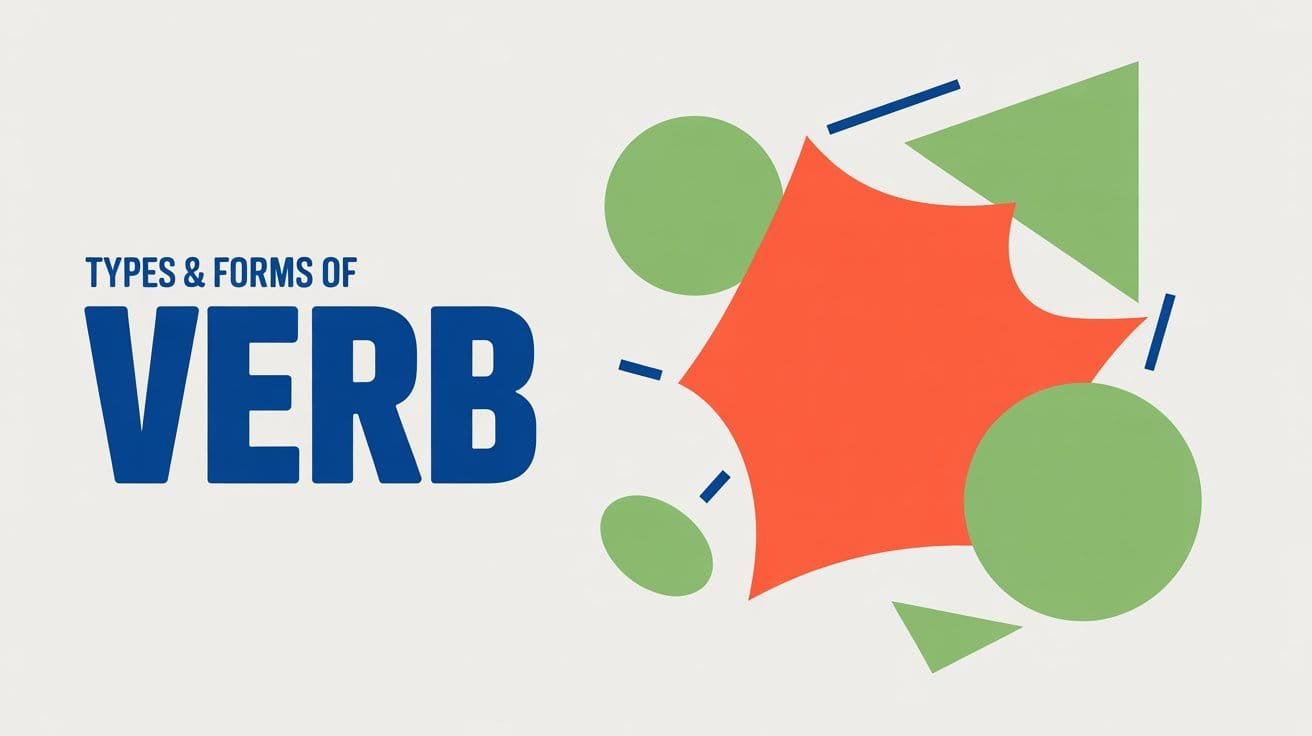A verb is one of the most important parts of a sentence. It tells us what the subject is doing or what state it’s in. Without a verb, a sentence can’t express a complete thought. Whether you’re talking about someone running, thinking, or simply being, you’re using a verb.
In this guide, you’ll learn what a verb is, the different types of verbs in English grammar, how verbs function in sentences, and how to recognize and use them correctly. Each section comes with simple explanations and examples to help you understand how verbs work in everyday English.
What is a Verb?
A verb is a word that expresses an action (like “walk,” “talk,” “write”) or a state of being (like “is,” “am,” “were”). It’s the part of a sentence that tells what the subject is doing or what is happening. In English grammar, verbs are one of the essential parts of speech, and every complete sentence needs one.
Here are some basic examples of verbs in use:
- She writes stories every day.
- They are excited about the trip.
- We have finished our homework.
In each case, the verb helps express either an action (writes, have finished) or a state (are).
Without verbs, communication would be incomplete. That’s why learning how to identify and use them correctly is a key step in understanding English sentence structure.
Functions of Verbs in a Sentence
Verbs do more than just show action—they serve several important roles in sentence structure.
Here are the main functions of verbs in English:
Expressing Action
This is the most common role of a verb. It shows what the subject does.
- The dog barked loudly.
- He reads every night.
Showing a State or Condition
Some verbs describe a condition or state of being rather than an action.
- She is tired.
- The soup smells delicious.
Linking the Subject to More Information
Linking verbs connect the subject to a subject complement (like an adjective or noun).
- The sky looks clear.
- He became a doctor.
Helping Other Verbs (Auxiliary Use)
Helping verbs combine with main verbs to show tense, voice, or mood.
- They have finished the project.
- We are going to the market.
Forming Questions or Negatives
Verbs also help form questions and negative sentences, especially with auxiliaries.
- Do you like apples?
- She does not understand the joke.
Types of Verbs in English
Verbs in English can be classified based on how they behave in a sentence—what they express and how they interact with other words. Below are the main types of verbs in English grammar, explained with definitions and examples.
Action Verbs
Action verbs describe what the subject does. These can be visible actions (run, jump) or internal processes (think, decide).
- Physical: Mila kicked the ball across the field.
- Mental: Ravi remembers the story vividly.
Action verbs are often the most recognizable type and form the core of many sentences.
Linking Verbs
Linking verbs do not express action. Instead, they connect the subject to additional information, often a noun or adjective that describes or renames the subject.
- Common linking verbs: be, seem, become, appear, feel
- Example: The soup tastes spicy.
- Example: He became anxious before the exam.
To test a linking verb, try replacing it with a form of “be.” If the sentence still makes sense, it’s likely a linking verb.
Auxiliary Verbs (Helping Verbs)
Auxiliary verbs, also called helping verbs, work with a main verb to show tense, aspect, mood, or voice. There are two types: primary auxiliaries and modal verbs.
- Primary auxiliaries: be, have, do
– Example: They have completed their assignments.
– Example: We are watching a movie tonight.
These verbs help form questions, negatives, continuous tenses, and the passive voice.
Modal Verbs
Modal verbs are a special type of auxiliary verb. They express ability, possibility, permission, necessity, or obligation.
- Common modal verbs: can, could, must, might, should, would
- Example: You must wear a helmet.
- Example: She can speak four languages.
Modal verbs always appear with a base verb and do not take -s or -ed endings.
Stative Verbs
Stative verbs describe conditions, emotions, relationships, thoughts, or possession. Unlike action verbs, they are not usually used in continuous (–ing) form.
- Common stative verbs: believe, own, love, prefer, know
- Example: I own a small bookstore.
- Example: She knows the answer.
Dynamic Verbs
Dynamic verbs describe actions or processes that involve movement, change, or activity. These verbs can be used in continuous (progressive) tenses to show that something is happening right now or over a period of time.
- Example: She is writing a report for her team.
- Example: They were playing football when it started raining.
Unlike stative verbs, which describe fixed conditions or mental states, dynamic verbs can express actions that start and stop. Some verbs, like think or have, can be dynamic or stative depending on how they’re used:
- Stative: I think it’s a good idea.
- Dynamic: I am thinking about the problem.
Transitive and Intransitive Verbs
Verbs can be either transitive or intransitive depending on whether they need a direct object to complete their meaning.
- A transitive verb needs an object:
– She wrote a letter. (“letter” is the object) - An intransitive verb stands alone:
– He slept soundly.
Some verbs can be both, depending on context:
- They run a business. (transitive)
- They run every evening. (intransitive)
Learning the difference between transitive and intransitive verbs helps with sentence construction and clarity.
Phrasal Verbs
Phrasal verbs combine a verb with a preposition or adverb (or both) to create a new meaning.
Example:
– Please turn off the lights.
– She looked into the issue.
– They gave up smoking last year.
These combinations can be separable or inseparable and are very common in everyday English.
Gerunds
A gerund is the –ing form of a verb that functions as a noun in a sentence.
Example:
– Swimming is excellent exercise.
– He enjoys reading before bed.
Gerunds are often used after certain verbs, prepositions, or as the subject of a sentence.
Verb Conjugation in English
Verb conjugation refers to how a verb changes form to match the subject, tense, number, and sometimes mood or voice. In English, conjugation is especially important when forming correct verb tenses and ensuring subject-verb agreement.
In simple terms, conjugating a verb means adjusting it to fit the context of a sentence. For example:
- I run every day.
- She runs every day.
- They ran yesterday.
- We are running now.
Each sentence uses a different verb form, even though the root verb is the same (run). These changes depend on the subject (I, she, they) and tense (present, past, continuous).
Basic Verb Conjugation Examples (Present, Past, Future)
| Subject | Base Verb | Present | Past | Future |
|---|---|---|---|---|
| I | walk | walk | walked | will walk |
| He/She | walk | walks | walked | will walk |
| They | walk | walk | walked | will walk |
Verb conjugation in English is relatively straightforward compared to other languages, but irregular verbs require memorization.
Conjugation with Auxiliary and Modal Verbs
Some verb forms rely on auxiliary verbs (be, have, do) or modal verbs (can, might, should) for proper conjugation.
- She is walking to work. (present continuous)
- They have walked a long distance. (present perfect)
- You should walk more often. (modal + base verb)
These combinations help form different tenses, express mood, and show voice (active or passive).
Verb Forms in English
In English, most verbs are learned and recognized through five main forms. These are often labeled as V1 to V5. These verb forms are essential for using tenses, constructing sentences, and forming the passive voice correctly.
| Form | Name | Example (Verb: Write) | Usage |
|---|---|---|---|
| V1 | Base Form | write | Used in simple present (I/We/They/You write) and with modals (can write) |
| V2 | Simple Past | wrote | Used for past simple tense (She wrote a letter) |
| V3 | Past Participle | written | Used in perfect tenses and passive voice (She has written a poem) |
| V4 | Present Participle | writing | Used in continuous tenses (He is writing) |
| V5 | Third Person Singular | writes | Used with he/she/it in present simple (He writes daily) |
Regular vs. Irregular Verbs
English verbs are divided into two main groups based on how they form their past tense and past participle: regular verbs and irregular verbs.
Regular verbs follow a predictable pattern. You simply add -ed to the base form to form both the past tense and the past participle.
Examples of Regular Verbs:
| Base Form (V1) | Past (V2) | Past Participle (V3) |
|---|---|---|
| walk | walked | walked |
| jump | jumped | jumped |
| clean | cleaned | cleaned |
Regular verbs are easy to learn because of their consistent structure.
On the other hand, Irregular verbs do not follow a standard pattern. Their past tense and past participle forms must be memorized because they often change completely.
Examples of Irregular Verbs:
| Base Form (V1) | Past (V2) | Past Participle (V3) |
|---|---|---|
| go | went | gone |
| eat | ate | eaten |
| take | took | taken |
Because there’s no rule to predict their forms, irregular verbs are often listed in verb charts and taught separately.
Use of Verbs in Active and Passive Voice
Verbs change structure depending on whether a sentence uses active voice or passive voice. This change affects how the sentence is formed and what part gets the focus.
In active voice, the subject performs the action. It’s the most direct and commonly used structure in English.
- Example: The chef prepared the meal.
- Example: Maria wrote the email.
In contrast, passive voice places emphasis on the object of the action. The sentence uses a form of the verb be followed by the past participle (V3) of the main verb.
- Example: The meal was prepared by the chef.
- Example: The email was written by Maria.
Here’s a quick comparison:
| Voice | Structure | Example |
|---|---|---|
| Active | Subject + Verb + Object | The manager approved the request. |
| Passive | Object + Be Verb + Past Participle (+ by…) | The request was approved by the manager. |
Verbs in the passive voice always require an auxiliary verb. Choosing between active and passive depends on what you want to emphasize—the doer or the receiver of the action.
How to Identify a Verb in a Sentence
To identify a verb in a sentence, look for the word that shows what the subject does, feels, or is. Verbs describe actions, events, or states. They often appear alone or with helping words and may change form based on tense or subject.
Here’s how to spot a verb, step by step:
Find the Word That Shows Action or State
The simplest way to locate a verb is to ask: What is the subject doing? or What is happening?
- The dog barked at the stranger.
- She looks tired after the meeting.
In both cases, the verb tells us either what action is being taken (barked) or what condition exists (looks).
Watch for Helping Verbs Before the Main Verb
Some verbs work in pairs or groups. Helping (auxiliary) verbs like is, was, has, and will often come before the main verb.
- They are planning a trip.
- He has completed the project already.
- She will arrive soon.
These extra words help form tenses or show intention.
Shift the Sentence to a Different Tense
If you’re unsure which word is the verb, try changing the sentence from present to past. The word that changes is usually the verb.
- Today: He drives to college.
- Yesterday: He drove to college.
This method works even when the verb isn’t next to the subject.
Check for Be + –ing (Continuous Tenses)
When a sentence has a form of the verb be (is, are, was, were) followed by a word ending in –ing, you’ve found a verb phrase.
- We are learning new skills.
- The baby was crying loudly.
This structure shows an action in progress.
Don’t Assume Every –ing or –ed Word Is a Verb
Some words that look like verbs act as adjectives or nouns, depending on their role in the sentence.
- The boiling water spilled over. (boiling = adjective)
- Jogging helps reduce stress. (jogging = noun/gerund)
If the word doesn’t show time, action, or state, it’s probably not functioning as a verb.
Identifying the verb in a sentence makes it easier to understand how the sentence is structured and how other elements—like subjects, objects, and modifiers—connect to it.
FAQs About Verbs in English
What are the main types of verbs in English?
The main types include action verbs, linking verbs, auxiliary verbs, modal verbs, stative verbs, dynamic verbs, transitive and intransitive verbs, phrasal verbs, and gerunds. Each type serves a different function in a sentence.
What is verb conjugation in English?
Verb conjugation is the process of changing a verb’s form to match the subject, tense, or mood. For example, “eat” becomes “eats” for he/she in present simple and “ate” in past simple.
Can a verb have more than one word?
Yes. A verb can appear as a verb phrase, especially when combined with helping verbs.
Example: She has been working all morning.
What is the difference between a verb and a gerund?
A verb shows action or state, while a gerund is the –ing form of a verb used as a noun.
Verb: They are swimming.
Gerund: Swimming is relaxing.
Are helping verbs and modal verbs the same?
Modal verbs are a specific type of helping verb that express mood or possibility (e.g. can, should, must). Helping verbs include broader verbs like be, have, and do, which support the main verb to form tense or voice.
How do I recognize a phrasal verb?
A phrasal verb combines a main verb with one or more particles (prepositions or adverbs) that change its meaning. Example: She gave up chocolate.
If removing the second word changes the meaning, it’s a phrasal verb.



